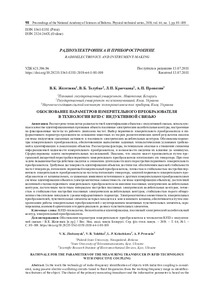Please use this identifier to cite or link to this item:
https://elib.psu.by/handle/123456789/25128| Title: | Обоснование параметров измерительного преобразователя в технологии RFID с индуктивной связью |
| Authors: | Железняк, В. К. Толубко, В. Б. Крючкова, Л. П. Провозин, А. П. Zheleznyak, V. Tolubko, V. Kriuchkova, L. Provozin, A. |
| Other Titles: | Rationale for the parameters of the measuring transducer in RFID technology with inductive coupling |
| Issue Date: | 2019 |
| Citation: | Обоснование параметров измерительного преобразователя в технологии RFID с индуктивной связью / В.К. Железняк [и др.] // Вес. Нац. акад. навук Беларусі. Сер. фіз.-тэхн. навук. – 2019. – Т. 64, №1. – С. 98–109. https://doi.org/10.29235/1561-8358-2019-64-1-98-109 |
| Abstract: | Рассмотрена технология радиочастотной идентификации объектов с индуктивной связью, использующая в качестве идентификационных признаков объекта пассивные электрические колебательные контуры, настроенные на фиксированные частоты из рабочего диапазона частот. Выбор первичного измерительного преобразователя и информативного параметра произведен на основании известных из теории радиотехнических цепей результатов анализа системы индуктивно связанных активного и пассивного электрических колебательных контуров. Обоснованы параметры измерительного преобразователя, обеспечивающие выполнение заданных технологическими условиями требований к идентификации и локализации объектов. Рассмотрены факторы, потенциально опасные в отношении снижения информационной надежности измерительного преобразователя, и возможности сведения их влияния до минимума. Сформулированы задачи экспериментальных исследований. Показано, что анализ может производиться путем программной дискретной перестройки первичного измерительного преобразователя и питающего его генератора. При этом задача повышения быстродействия сводится к снижению длительности шага перестройки первичного измерительного преобразователя. Требуемая достоверность идентификации объектов достигается: обеспечением высокой стабильности частот генератора, питающего первичный измерительный преобразователь; точностью и стабильностью настройки первичного измерительного преобразователя на частоты питающего генератора; защитой первичного измерительного преобразователя от влияния помех, создаваемых внешними источниками и другими измерительными преобразователями системы идентификации объектов (электромагнитная совместимость системы идентификации объектов); достаточной величиной отклика первичного измерительного преобразователя на внесение пассивных электрических колебательных контуров; достаточным частотным интервалом настройки пассивных электрических колебательных контуров; точностью и стабильностью настройки пассивных электрических колебательных контуров; стабильностью порога обнаружения относительно начального уровня информативного параметра. Электромагнитная совместимость измерительных преобразователей, чувствительные элементы которых находятся в зоне взаимного влияния, обеспечивается путем синхронизации работы измерительных преобразователей с шунтированием неактивных чувствительных элементов, экранирования, взаимной ориентации и территориального разноса чувствительных элементов.=In the work the technology of radio-frequency identification of objects with inductive coupling is considered, using passive electric oscillating circuits tuned to fixed frequencies from the working frequency range as identification features of the object. The choice of the primary measuring transducer and the informative parameter is based on the results of the analysis of the system of inductively coupled active and passive electric oscillation circuits, known from the theory of radio engineering circuits. The parameters of the measuring transducer ensuring the fulfillment of the requirements for identification and localization of objects specified by technological conditions are substantiated. Factors that are potentially dangerous with respect to reducing the information reliability of the measuring transducer are considered, as well as the possibility of reducing their influence to a minimum. The problems of experimental research are formulated. It is shown that the analysis can be performed by software discrete adjustment of the primary measuring transducer and the generator feeding it. In this case, the task of increasing the speed is targeted at decreasing the duration of the step of tuning the primary measuring transducer. The required reliability of object identification is achieved by: ensuring high stability of the frequencies of the generator supplying the primary measuring transducer; accuracy and stability of tuning of the primary measuring transducer to the frequencies of the supplying generator; protection of the primary measuring transducer from the influence of interference generated by external sources and other measuring converters of the object identification system (electromagnetic compatibility of the object identification system); sufficient magnitude of the response of the primary measuring transducer to the introduction of passive electrical oscillation circuits; sufficient frequency tuning interval for passive electric oscillation circuits; accuracy and stability of tuning of passive electric oscillation circuits; stability of the detection threshold relative to the initial level of the informative parameter. Electromagnetic compatibility of measuring transducers, whose sensing elements are in the zone of mutual influence, is provided by synchronizing the operation of measuring transducers with shunting of inactive sensors, screening, mutual orientation and spacing of sensing elements. |
| Keywords: | RFID-технология Бесконтактная идентификация Пассивный электрический колебательный контур Измерительный преобразователь RFID technology Contactless identification Passive electric oscillation circuit Measuring transducer |
| URI: | https://doi.org/10.29235/1561-8358-2019-64-1-98-109 https://elib.psu.by/handle/123456789/25128 |
| Appears in Collections: | Техническая защита информации |
Files in This Item:
| File | Description | Size | Format | |
|---|---|---|---|---|
| 425-684-1-SM.pdf | 1.5 MB | Adobe PDF |  View/Open |
Items in DSpace are protected by copyright, with all rights reserved, unless otherwise indicated.